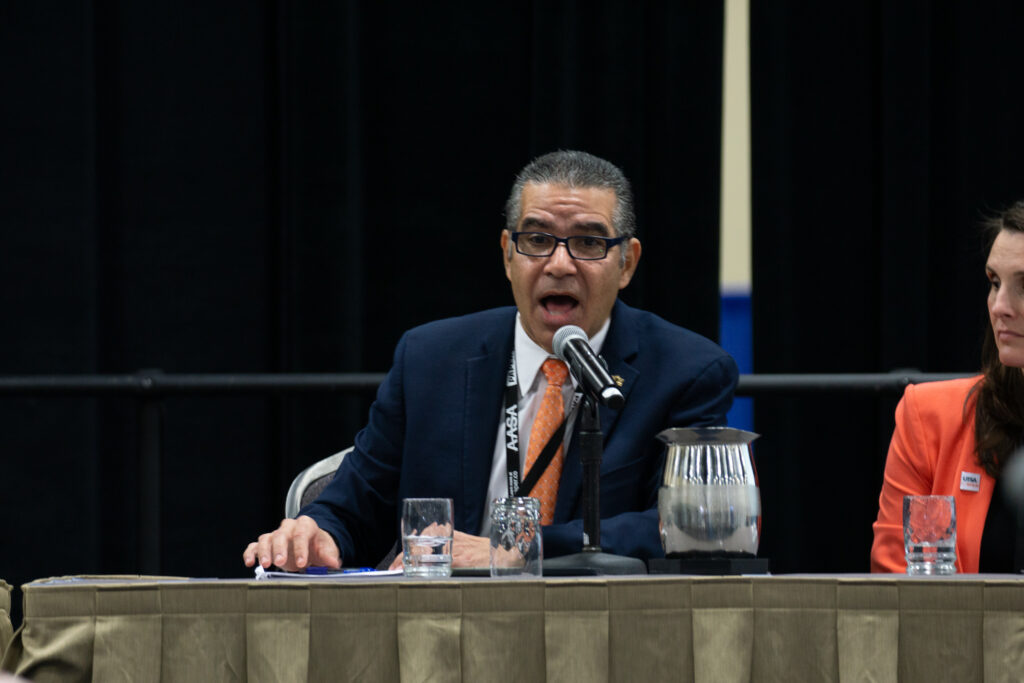Re-imagining a learning pathway for students from kindergarten through four years of college is a reality in Bear County, Texas, where San Antonio-based educators discussed the high points of their K20 partnership that defied even the darkest days of the coronavirus pandemic.
Their stories were shared during a panel session at an AASA national conference session on Thursday titled “Delivering and Executing a Re-Imagined K20 Learning Pathway.”
Providing supports that students need throughout their educational careers, with a focus on student outcomes, drives the partnerships that connect schoolhouse to campus, diploma to degree, according to Mike Flores, chancellor of the Alamo College District and its five community colleges, including San Antonio College in Bear County.
Roughly 70 percent of the 100,000 students enrolled annually in Alamo are reliant on need- or merit-based financial support. “We actually don’t compete with UTSA (the University of Texas at San Antonio),” Flores told a conference audience. “We actually compete with poverty and whether students can afford not only their tuition, but also working less hours and giving less of their paychecks” to help pay family bills.
Nationwide, college enrollment dropped significantly in 2020, with the onset of the coronavirus pandemic and its impact on finances and human interaction. “Unfortunately, in 2021 it did not get any better,” said Ricardo Torres, president and CEO of the National Student Clearinghouse, and another of the panelists. “There was no recovery at all.”
But in Bear County, there were no dips, no plunges, making for an “interesting anomaly” worthy of deeper discussion, Torres said.

Indeed, San Antonio College has seen a steady increase in enrollment over the past six years, with an all-time high of 68,319 in fall 2020. According to Flores, 90 percent of the students are employed or enrolled in a university within six months of graduation. Moreover, a year has been shaved off the average time it takes a student to earn an associate degree, saving both time and money.
Like-minded partnership initiatives include industry-based certifications, dual enrollment, college visits, free testing, alumni network mentors, paid internships, job fairs, a summer momentum program to bridge the transition from high school graduation to the first days of colleges and case managers who engage intentionally with students about their studies and their future.
Likewise, staff working as “postsecondary navigators” work with high school graduates to ensure they stay on track in college. One such case involved a student set to leave school because her computer broke, said Jaime Aquino, superintendent of the San Antonio Independent School District. Foundation money was secured to buy her a new computer.
According to Acquino, 52 percent of his high school students have enrolled in their first semester of college, the highest rate since 2014, “and it’s three points higher than the great state of Texas.”
“As an immigrant with a second language learned, I have a special connection with my students,” Aquino said. “Their stories are my story. Their struggles are my struggle. We’re showing [people] that the way the kids come to us is no excuse for the way they leave us.”
Heather Shipley, UTSA’s senior vice president of academic affairs and dean of the university, said her school’s 60 percent Hispanic enrollment reflects the city’s makeup. Among its partnership initiatives, the Alamo Runner Program allows students who receive guaranteed USTA admission the option to start at community college.
“We have to make sure that we continue to provide [students] the resources to be successful,” Shipley said. The re-imagined K20 model “is a partnership,” she added. “Our mission is to provide access and help this city move forward, and we do that through collaboration, not competition.”
(Linda Chion is a senior editor with Conference Daily Online and a freelance editor and writer in Lithia, Fla.)


